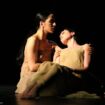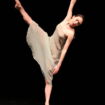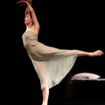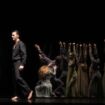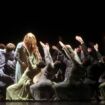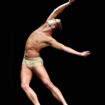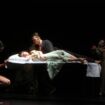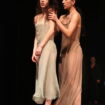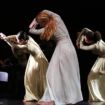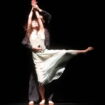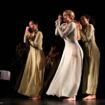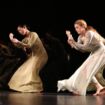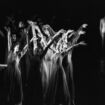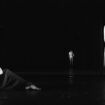The film recording shows a clip from the performance on 23th November 2013.
PROJECTS
> DOCUMENTATION 2013
The project documentation shows, among other things, how Jo Anne Endicott and John Giffin taught the choreography to the young dancers.
Pina Bausch Foundation:
Wind von West (Cantata)
Wind von West, the first part of the three-part Stravinsky evening Frühlingsopfer (Rite of Spring), could be seen again in 2013 (for the first time since 1979) as part of PINA40, the 40-year anniversary season marking the founding of Tanztheater Wuppertal Pina Bausch. It was danced by members of the Folkwang Dance Studio as well as students from the Institute for Contemporary Dance at the Folkwang University of the Arts and the Juilliard School in New York. Rehearsals were led by former Tanztheater Wuppertal dancers, some of whom – Josephine Ann Endicott, John Giffin and Mari DiLena – had also danced in the original premiere.
Rehearsals were held in Essen and New York throughout 2013 and spread over four phases, some of which lasted several weeks.
Material available in the Pina Bausch Archive was used to support the rehearsal process while and stage design and costumes were reconstructed with the help of Tanztheater Wuppertal.
Interview with Josephine Anne Endicott and John Giffin
The former dancers Josephine Ann Endicott and John Giffin talk about their time at the Tanztheater Wuppertal. It was here that they worked with Pina Bausch on Wind von West (Cantata), which was premiered in 1975. For the reconstruction, both dancers as well as Mari DiLena, Vivienne Newport and Dominique Mercy shared their knowledge with members of the Folkwang Dance Studio as well as students from the Institute for Contemporary Dance at the Folkwang University of the Arts and the Juilliard School in New York.
JOSEPHINE ANNE ENDICOTT
was born in Sydney/Australia in 1950. In 1966, she was selected for the Australian Ballet School in Melbourne and was taken into the Australian Company two years later. She lived in London from 1972 onwards. It was here, in 1973, that she met Pina Bausch who took her as a solo dancer for her Wuppertal Dance Theatre. She left the company in 1987 in order to start a family but returned four years later in 1991, mostly as a guest dancer, but also with fixed contracts, for example for Kontakthof or revivals. Since February 2007, she has been working on a permanent contract with the ensemble in Wuppertal – as head of rehearsals, as assistant and dancer, and for the film archive of the Pina Bausch Foundation. Her working journal Ich bin eine anständige Frau! was published in 1999. Her second book, Warten auf Pina, in which she reflects on her work with Pina Bausch, was published in 2009. She has also worked as a choreographer in all of Germany’s best-known opera houses. In 2002, she created her own one-woman show Gala for one. She has appeared in numerous films and received many awards. She gave her final performance as a dancer in the piece Komm tanz mit mir in June 2010 in Tokyo. Her most recent pieces for Tanztheater Wuppertal were Wind von West and Der Zweite Frühling for the PINA40 festival marking 40 years of Tanztheater Wuppertal Pina Bausch in November 2013.
JOHN GIFFIN
obtained a B.F.A. in dance from the Juilliard School and an M.A. in dance from the Ohio State University’s Department of Dance where he is now Professor Emeritus. He has received Choreographic Fellowships for his creative works from the National Endowment for the Arts, the Ohio Arts Council and the Greater Columbus Arts Council. These works include six full-evening pieces, a commission from Rhythm in Shoes in Dayton and a co-production with the Contemporary American Theatre Company in Columbus. He has danced professionally with Les Grands Ballets Canadiens in Montreal, with Agnes DeMille’s Heritage Dance Theatre and with Brigadoon in NYC. He has also toured internationally with Tanztheater Wuppertal, directed by Pina Bausch. He created roles in many of Bausch’s seminal works including Fritz, Iphigenie auf Tauris, Blaubart, Komm tanz mit mir, Renate wandert aus, Kontakthof and Arien. In 2013, Giffin collaborated with the Pina Bausch Foundation to reconstruct Bausch’s 1975 piece Wind von West for performances by the Folkwang University of the Arts in Germany and the Juilliard School in the USA.
Choreography – Pina Bausch
Stage and costume – Rolf Borzik
Assistant – Hans Pop
Rehearsal direction for the 2013 reconstruction – Josephine Ann Endicott, John Giffin and Mari DiLena
Rehearsal assistants – Tjitske Broersma, Ed Kortlandt and Vivienne Newport
Dancers – Pedro Mascarello Bisch, Hiltrud Blanck, Sue Cooper, Fernando Cortizo, Michael Diekamp, Esco Edmondson, Laszlo Fenyves, Colleen Finneran, Lajos Horvath, Margaret Huggenberger, Yolanda Meier, Stephanie Macoun, Vivienne Newport, Barbara Passow, Heinz Samm, Monika Wacker and Barry Wilkinson
- 22 November 2013 | Opernhaus Wuppertal – with an ensemble comprising Folkwang und Juilliard dancers – premiere
- 23 November 2013 | Opernhaus Wuppertal – with an ensemble comprising Folkwang und Juilliard dancers
- 24 November 2013 | Opernhaus Wuppertal – with the Folkwang ensemble
- 26 November 2013 | Aalto-Theater Essen – with the Folkwang ensemble
- 11 December 2013 | Peter Jay Sharp Theatre, New York City – with an ensemble comprising Folkwang und Juilliard dancers
- 12 December 2013 | Peter Jay Sharp Theatre, New York City – with an ensemble comprising Folkwang und Juilliard dancers
- 13 December 2013 | Peter Jay Sharp Theatre, New York City – with the Juilliard School ensemble
- 14 December 2013 | Peter Jay Sharp Theatre, New York City – with the Juilliard School ensemble
- 15 December 2013 | Peter Jay Sharp Theatre, New York City – with the Juilliard School ensemble
